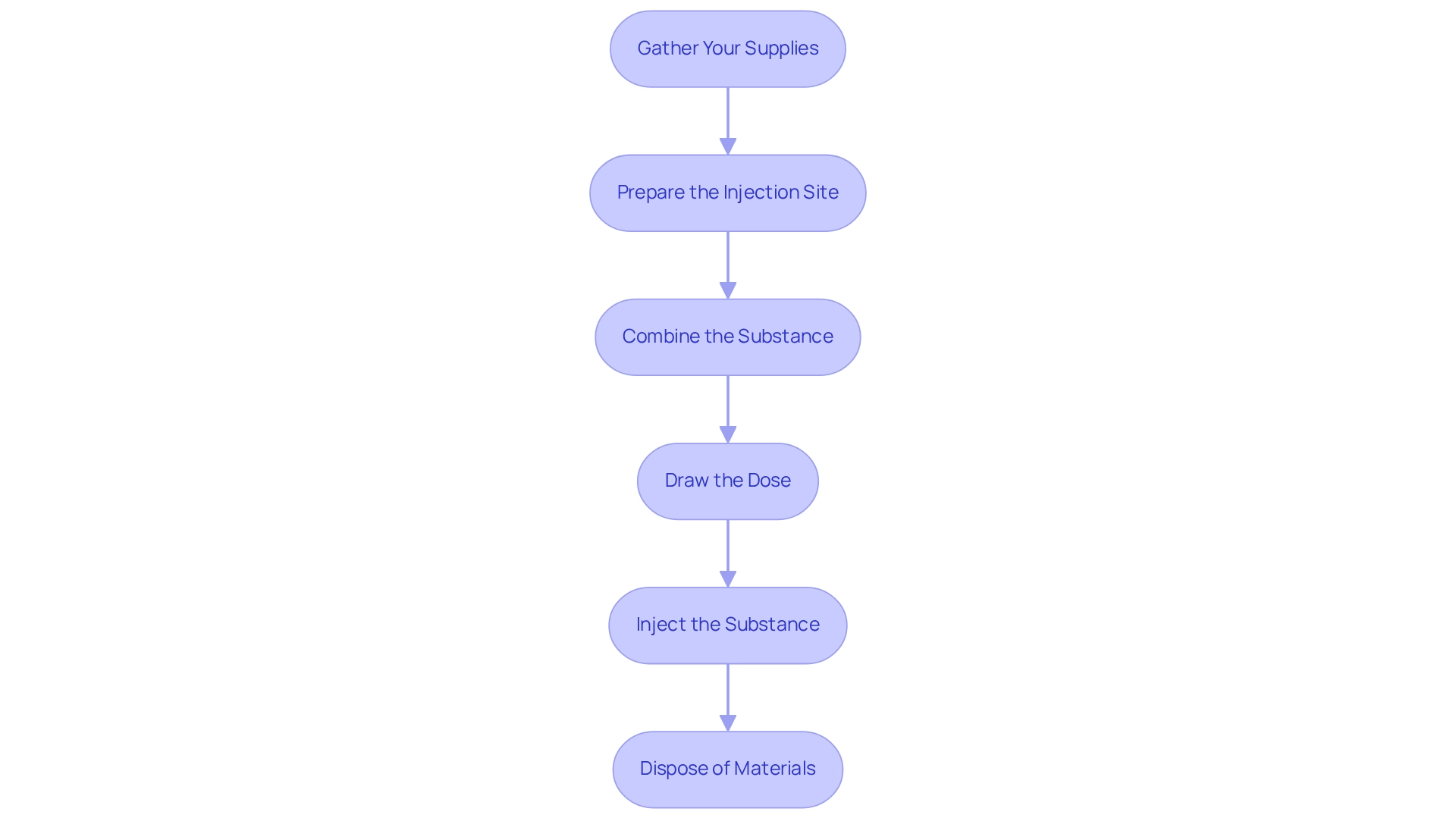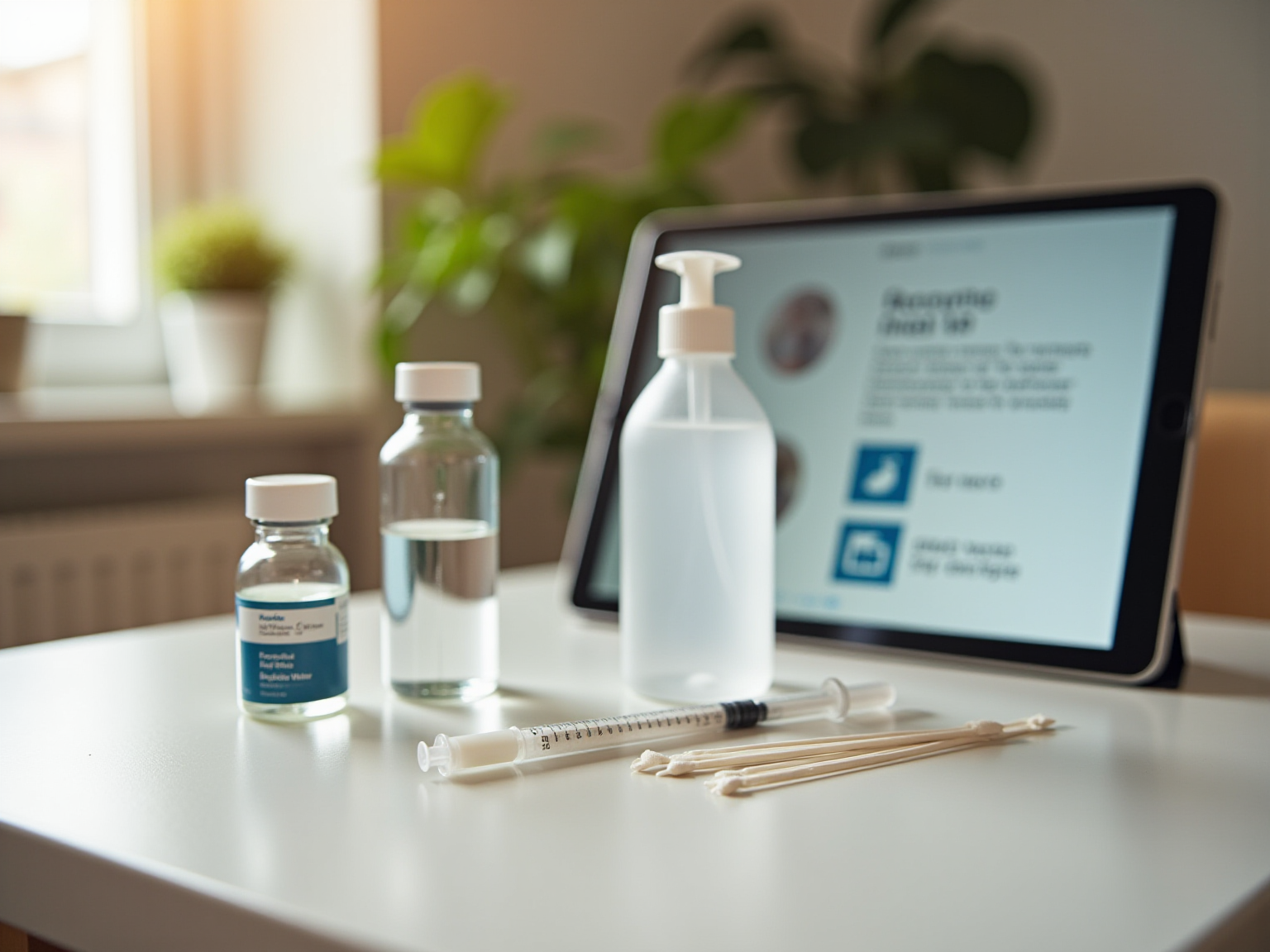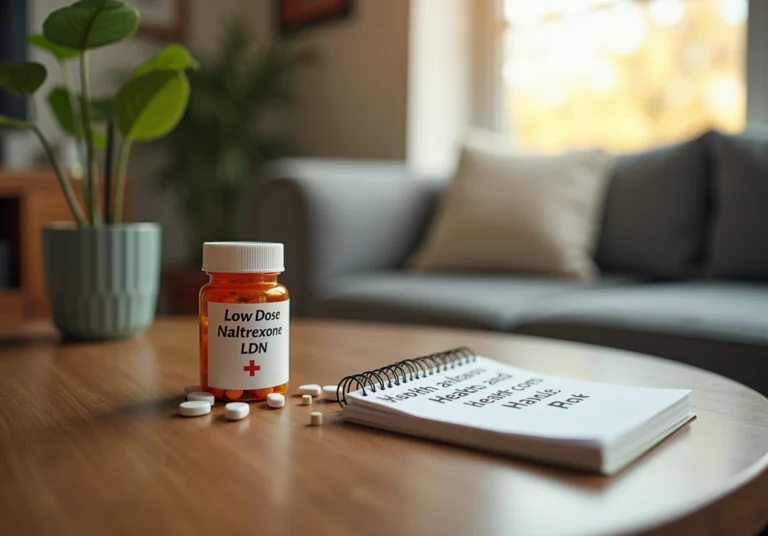Peptide Therapy at Home: Steps for Safe Administration
Overview
Peptide therapy at home can be safely administered by following specific steps. These include:
- Preparing the injection site
- Mixing the peptide with bacteriostatic water
- Disposing of materials properly
Adhering to these protocols is crucial to enhance both safety and effectiveness. Furthermore, it is essential to address potential side effects, such as joint pain and insulin resistance. Careful monitoring and consultation with healthcare professionals are necessary to mitigate these risks.
Introduction
In the evolving landscape of modern medicine, peptide therapy is emerging as a groundbreaking approach to health and wellness. This innovative therapy harnesses the power of specific amino acid sequences to modulate essential biological processes, including hormone regulation, muscle growth, and recovery. As interest in anti-aging solutions rises, peptides such as oxytocin and BPC-157 are gaining attention for their potential benefits. Furthermore, the integration of traditional therapies offers a promising avenue for enhanced health outcomes.
However, navigating the complexities of peptide therapy requires a clear understanding of its mechanisms, applications, and safety considerations. With ongoing research illuminating the path forward, individuals are increasingly empowered to explore this dynamic field and its implications for their health journeys. Are you ready to delve into the world of peptide therapy and discover how it can transform your health?
Understand Peptide Therapy Basics
Amino acid sequences, known as peptides, are crucial for influencing various biological processes within the body. These compounds play an essential role in regulating hormones, enhancing muscle growth, improving recovery times, and promoting overall well-being. Understanding the fundamental processes behind protein-based treatments like peptide therapy at home is vital for individuals considering their inclusion in a health routine, especially concerning anti-aging advancements.
Recent studies highlight the potential of compounds like oxytocin, recognized for its anti-aging benefits, to enhance conventional treatments such as low-dose naltrexone. This treatment is gaining popularity due to its unique effects on the body’s opioid receptors and inflammation. However, it is important to consider the potential side effects of human growth hormone therapy, which may include joint pain, swelling, and an increased risk of diabetes.
Peptides can be either naturally occurring or synthetically produced, with administration typically occurring via injections. This method is preferred for its efficiency, allowing for rapid absorption into the bloodstream and swift therapeutic effects. Recent advancements in protein synthesis, including electrochemical techniques that utilize recyclable reagents, have improved the sustainability of production while maintaining high reaction yields.
A systematic investigation has shown that altering the composition of green binary solvent mixtures can minimize side reactions during protein synthesis, further enhancing the process. As research continues to evolve, the effectiveness of this treatment is increasingly supported by systematic investigations, with studies indicating that this approach can lead to significant improvements in health outcomes.
According to Santosh Kulkarni, lead of the medicinal chemistry team in discovery services, “Peptides influence biological processes in ways that can be both profound and beneficial, making them a valuable tool in modern medicine.” For those seeking additional information, FAQs related to peptide therapy at home can offer valuable insights into its applications and considerations.
Explore Common Peptides Used in Therapy
In therapeutic settings, several peptides are widely utilized, particularly in peptide therapy at home, each offering distinct advantages.
- BPC-157: Renowned for its remarkable healing properties, BPC-157 is frequently employed to accelerate recovery from injuries and mitigate inflammation. Recent studies highlight its efficacy in promoting tissue repair, making it a valuable asset in regenerative medicine. It is often recommended to use BPC-157 in conjunction with TB4 for enhanced therapeutic effects.
- Ipamorelin: This peptide is a powerful stimulator of hormone release, which supports muscle development and facilitates fat loss. Recent studies suggest that administering Ipamorelin in the evening can improve its efficacy by simulating the body’s natural hormone surge during deep sleep, optimizing recovery and muscle development. It is crucial to follow safety guidelines when purchasing Ipamorelin to avoid counterfeit products and ensure quality.
- CJC-1295: Often paired with Ipamorelin, CJC-1295 amplifies growth hormone levels and enhances recovery processes. This combination is particularly favored for its synergistic effects, leading to improved muscle mass and overall vitality.
- Semaglutide: Primarily recognized for its role in weight management, Semaglutide aids in regulating appetite and glucose levels, making it an effective option for individuals seeking to achieve and maintain a healthy weight.
Understanding these compounds and their specific uses allows individuals to make informed decisions about their wellness goals and treatment options, such as peptide therapy at home. As R2 Medical Clinic states, “Your health and progress are our top priorities, and we’re always here to answer questions and address concerns.” Furthermore, a typical cycle involving a common compound lasts around four months, comprising three months on and one month off, offering an organized method to treatment. Recent research from 2025 continues to support the benefits of BPC-157, further solidifying its role in modern therapeutic practices.

Follow Steps to Administer Peptide Therapy at Home
To safely administer peptide therapy at home, follow these essential steps:
- Gather Your Supplies: Collect all necessary items, including the protein vial, bacteriostatic water, a syringe, alcohol swabs, and a sharps container for safe disposal.
- Prepare the Injection Site: Choose an appropriate injection area, typically the abdomen or thigh, and clean it thoroughly with an alcohol swab to minimize the risk of infection.
- Combine the Substance: Remove the caps from both the solution and bacteriostatic water vials. Using the syringe, draw the required amount of bacteriostatic water and inject it into the vial containing the protein. Gently swirl the vial to ensure proper mixing.
- After mixing, carefully draw the prescribed dose of the compound into the syringe, ensuring accuracy for effective treatment.
- Inject the Substance: Pinch the skin at the injection site, insert the needle at a 45-degree angle, and inject the solution slowly to reduce discomfort. Withdraw the needle and apply pressure with a cotton ball to minimize bleeding.
- Dispose of Materials: Properly dispose of the needle and syringe in a designated sharps container to ensure safety and compliance with health regulations.
According to recent statistics, the protein-based treatments market is anticipated to show considerable expansion, reflecting an increasing interest in self-administered treatments. A healthcare expert stresses, “Adhering to appropriate protocols for protein injections can greatly improve safety and effectiveness.” By following these steps, you can ensure a secure and efficient self-administration procedure for peptide therapy at home, which contributes to your overall well-being and wellness journey. Furthermore, case studies have demonstrated that individuals who adhere to these guidelines report favorable results, emphasizing the significance of informed practices in protein treatment.

Recognize Safety and Side Effects of Peptide Therapy
Peptide treatment can provide various health benefits; however, it is crucial to recognize potential side effects. These may include:
- Joint Pain and Swelling: Some individuals may experience joint pain or swelling, which can be uncomfortable and may require attention.
- Insulin Resistance: There is a potential risk of developing insulin resistance, affecting metabolic health.
- Increased Risk of Diabetes: Long-term use of certain treatments may be associated with an increased risk of diabetes, necessitating careful monitoring.
- Cancer Risk: Long-term use may also be linked to an increased risk of certain cancers, highlighting the importance of ongoing research and monitoring.
To mitigate these risks, it is essential to adhere strictly to dosing instructions. Furthermore, consult a healthcare provider if any concerning symptoms arise. Regular monitoring and maintaining open communication with a healthcare professional are vital for ensuring a safe and effective experience with peptide therapy at home.

Conclusion
Peptide therapy represents a significant advancement in modern medicine, offering a variety of health benefits through the modulation of biological processes. By leveraging specific amino acid sequences, peptides such as BPC-157, Ipamorelin, and CJC-1295 have shown promise in enhancing recovery, promoting muscle growth, and supporting overall well-being. As our understanding of these therapies deepens, individuals can make informed decisions about their health and explore the potential of peptides as part of their wellness journey.
However, it is essential to approach peptide therapy with caution. Awareness of possible side effects, including joint pain, insulin resistance, and potential long-term health risks, is crucial. Following proper administration protocols and maintaining open lines of communication with healthcare providers will help mitigate these risks and ensure a safe therapeutic experience.
As research continues to evolve, the landscape of peptide therapy is becoming clearer, providing exciting opportunities for individuals seeking innovative solutions for health and longevity. By embracing this cutting-edge approach while prioritizing safety and informed practices, individuals can unlock the potential of peptide therapy to transform their health and enhance their quality of life. The journey into peptide therapy is not just about treatment; it’s about empowerment and taking proactive steps towards achieving optimal health.
Frequently Asked Questions
What are peptides and why are they important?
Peptides are amino acid sequences that play a crucial role in influencing various biological processes in the body. They are essential for regulating hormones, enhancing muscle growth, improving recovery times, and promoting overall well-being.
How does peptide therapy relate to anti-aging advancements?
Peptide therapy is significant for individuals considering health routines that include anti-aging advancements, as it helps in understanding the fundamental processes behind protein-based treatments.
What are some potential benefits of compounds like oxytocin in peptide therapy?
Compounds like oxytocin are recognized for their anti-aging benefits and can enhance conventional treatments such as low-dose naltrexone, which affects the body’s opioid receptors and inflammation.
What are the potential side effects of human growth hormone therapy?
Potential side effects of human growth hormone therapy may include joint pain, swelling, and an increased risk of diabetes.
How are peptides typically administered in therapy?
Peptides are usually administered via injections, which allows for rapid absorption into the bloodstream and swift therapeutic effects.
What advancements have been made in the production of peptides?
Recent advancements include electrochemical techniques using recyclable reagents to improve sustainability in peptide production while maintaining high reaction yields.
How can altering the composition of green binary solvent mixtures affect protein synthesis?
Altering the composition of green binary solvent mixtures can minimize side reactions during protein synthesis, thereby enhancing the overall process.
What is the current state of research on peptide therapy?
Research is evolving, with systematic investigations showing that peptide therapy can lead to significant improvements in health outcomes, supporting its effectiveness.
Who is Santosh Kulkarni and what is his perspective on peptides?
Santosh Kulkarni is the lead of the medicinal chemistry team in discovery services, and he states that peptides influence biological processes in ways that can be both profound and beneficial, making them a valuable tool in modern medicine.
Where can I find more information about peptide therapy at home?
For additional information, FAQs related to peptide therapy at home can provide valuable insights into its applications and considerations.






